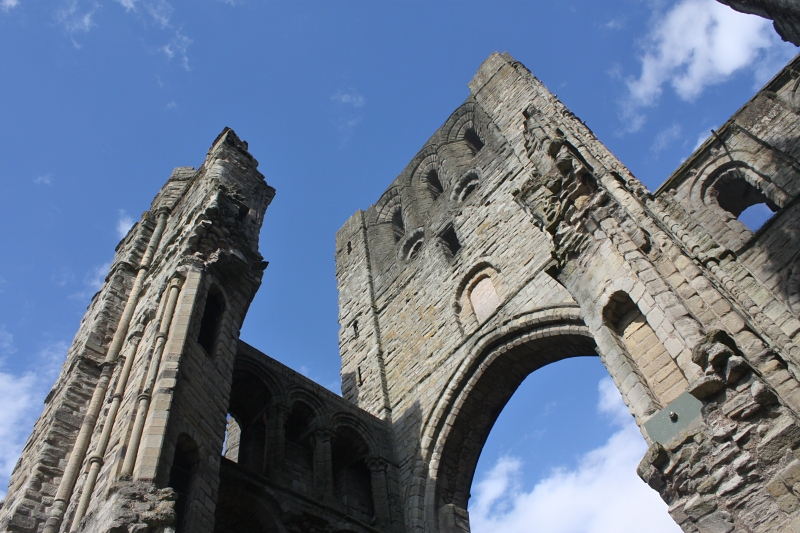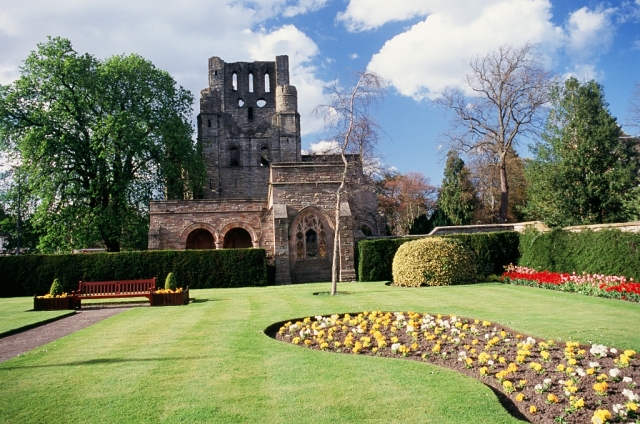
The border abbeys, one from each of the four main monastic orders, form a significant group and the route to each is well marked. It's almost noon by the time we arrive at Kelso, which is about fifteen miles east of Melrose.
We take the only spot in the car park expecting the abbey to be crawling with other visitors, but it's not. As we approach the ruins, which tower over us in the clearing sky, we all come to a stop and stare in dismay.
Crumbling and war-torn, what little remains of Kelso endured over four centuries of cross-border turmoil. Founded in 1128, by King David I, this house of Tironensian monks was taken by Edward I of England in 1297 and remained in English hands until 1450. It was finally destroyed by the Earl of Hertford during Henry VIII's "Rough Wooing."
I realize as I stand staring up at the remains that, though we have been referring to many places we have visited as "ruins", Kelso Abbey really puts the word into context. It seems gaunt, wasted, uncared for.
The village of Kelso is situated on the north bank of the Tweed in Roxburghshire, and has grown up around the abbey, encroaching on its lands. The proximity of present day businesses and traffic make it impossible to visualize what this abbey and its grounds would have looked like when the monks were in residence here. We are all a little introspective and a little disappointed. There seems to be such a lack of respect and care for this once great establishment.
Though the grass in the immediate vicinity of the abbey has been recently mowed, trash litters the ground between the abbey and the graveyard. We follow a walkway through the graveyard, which is in extremely sad repair with more headstones toppled and shattered than not. The grass is high, the shrubs are overgrown and diseased. Fast food wrappers and newspapers lie in clumps here and there, even though there are several rubbish bins present.
Exiting out onto the street, we make our way to the Scottish Tourist Board nearby. Inside we discover that there isn't a visitor's guide for the abbey; another indication of the apparent lack of interest and attention in honoring the abbey and its history.
In the tourist board shop I purchase a book on Scottish monasteries in the middle ages (Kelso barely gets a mention and is one of very few not pictured) and a book on Holy Island, which we missed seeing the day before due to the weather.
We crossing the street and do a bit of window shopping on an alternate route back to the car park, stopping in front of a shop called Nature's Way. Robin's been looking for heather soap as a gift for a friend, and there is a bar of it in the window, which I point out to her. I've been looking for heather bubble bath as a gift for a friend back home, but there's none to be seen. Into the shop we go for a better look around.
We have a brief humorous exchange with the gentleman who is tending the shop. I get the impression that he is filling in for his wife, as he has a buddy there with him and they seem a little out of place among all the perfumed soaps and botanical body lotions. We ask for help after failing to find heather soap stocked on the shelves. The man replies that they don't have any heather soap. "Yes you do," Robin says. "It's right there in the window."
He steps outside with Robin, peering into the window as if he's seeing the place for the first time. "Leave it to a woman to tell you what you do and don't have," he quips to his friend as he returns to the store and removes the sole cake of heather soap from the display.
Walking back through the graveyard, we head toward the car park. I take one last look over my shoulder at the Abbey. I think of the exquisite ruins of Byland, Rievaulx and Fountains abbeys, knowing that the fundamental reason for the difference in the condition of the remains is location – the relative invulnerability of Yorkshire as opposed to the upheaval of the Borders.
As we set off toward Jedburgh, I no longer see Kelso as ruined. I see it as stalwart and proud, defiant and enduring – a survivor, with well earned battle scars and a commanding presence that defies time and indifference.

Kelso Abbey is a ruined Scottish abbey in Kelso, Scotland. It was founded in the 12th century by a community of Tironensian monks first brought to Scotland in the reign of Alexander I. It occupies ground overlooking the confluence of the Tweed and Teviot waters, the site of what was once the Royal Burgh of Roxburgh and the intended southern center for the developing Scottish kingdom at that time.
Although the site of Kelso Abbey has not been fully excavated in modern times, evidence suggests that it was a major building with two crossings. The only remains standing today are the west tower crossing and part of the infirmary. The massive design and solid Romanesque style of the tower indicate a very large building of formidable, semi-military construction and appearance.
Read more about Kelso Abbey